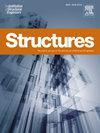Research on load-bearing mechanism and estimation of steel tube-corrugated steel plate composite walls under axial compression
IF 4.3
2区 工程技术
Q1 ENGINEERING, CIVIL
引用次数: 0
Abstract
The Steel tube-corrugated steel plate composite wall (STCPCW) is a novel structural component developed to resist shear forces induced by horizontal loads in high-rise buildings, while also requiring the capacity to support gravity loads that induce compression. To investigate its performance under axial compression, both experimental and numerical studies were conducted. Two STCPCW specimens with different widths of corrugated cell (bw) were tested, both exhibiting cross-sectional failure. As the bw increased from 500 mm to 1000 mm, the ductility index decreased by 45.7 %. A finite element model was developed to simulate the load-bearing mechanism of STCPCW under axial compression and was validated using the test results. Further numerical analysis revealed that the infilled concrete wall exhibited distinct behavior in response to the varying confinement provided by corrugated steel plates (CSPs). Once the equivalent width-to-thickness ratio of the CSPs reached 60, the confinement effect of the CSPs became minimal. Consequently, the axial compressive performance of the infilled concrete wall was evaluated under two scenarios. When the confinement is minimal, the load-bearing capacity of the infilled concrete wall is predominantly influenced by the configuration of the concrete wall and the strength of the concrete; when the confinement is effective, the confinement effect of the CSPs and steel tubes becomes the primary factor. Additionally, the reduction caused by insufficient ductility of the infilled concrete wall when calculating the load-bearing capacity of STCPCWs was assessed using a discount factor, β. Finally, a practical estimation of the load-bearing capacity of the STCPCWs under axial compression was proposed.
钢管-波纹钢板复合墙体轴压承载机理研究及估算
钢管-波纹钢板复合墙体(STCPCW)是一种新型的结构构件,用于抵抗高层建筑中水平荷载引起的剪切力,同时也要求能够承受引起压缩的重力荷载。为了研究其在轴向压缩下的性能,进行了实验和数值研究。对两种不同宽度波纹槽(bw)的STCPCW试件进行了试验,均表现出截面破坏。当厚度从500 mm增加到1000 mm时,延性指数下降45.7% %。建立了模拟STCPCW轴向压缩受力机理的有限元模型,并利用试验结果进行了验证。进一步的数值分析表明,填充混凝土墙对波纹钢板(CSPs)提供的不同约束具有不同的响应行为。当CSPs的等效宽厚比达到60时,CSPs的约束效应最小。因此,在两种情况下对填充混凝土墙体的轴压性能进行了评价。当约束最小时,墙体的承载能力主要受墙体结构和混凝土强度的影响;当约束有效时,csp和钢管的约束作用成为主要影响因素。此外,在计算STCPCWs的承载能力时,填充混凝土墙延性不足造成的减少使用贴现系数β进行评估。最后,对STCPCWs在轴压作用下的承载能力进行了实用估计。
本文章由计算机程序翻译,如有差异,请以英文原文为准。
求助全文
约1分钟内获得全文
求助全文
来源期刊

Structures
Engineering-Architecture
CiteScore
5.70
自引率
17.10%
发文量
1187
期刊介绍:
Structures aims to publish internationally-leading research across the full breadth of structural engineering. Papers for Structures are particularly welcome in which high-quality research will benefit from wide readership of academics and practitioners such that not only high citation rates but also tangible industrial-related pathways to impact are achieved.
 求助内容:
求助内容: 应助结果提醒方式:
应助结果提醒方式:


